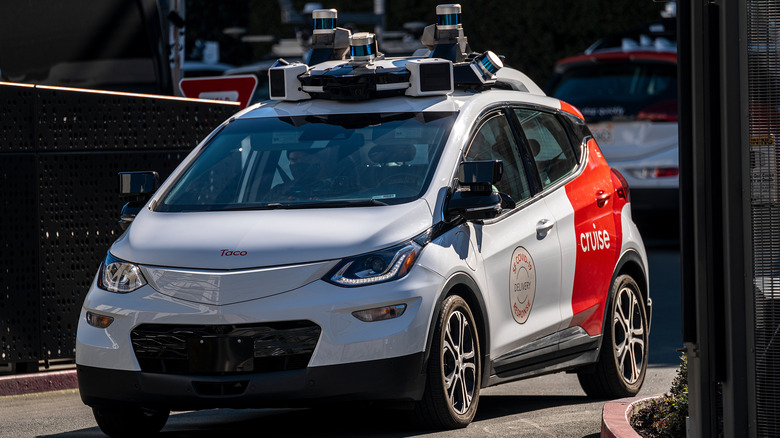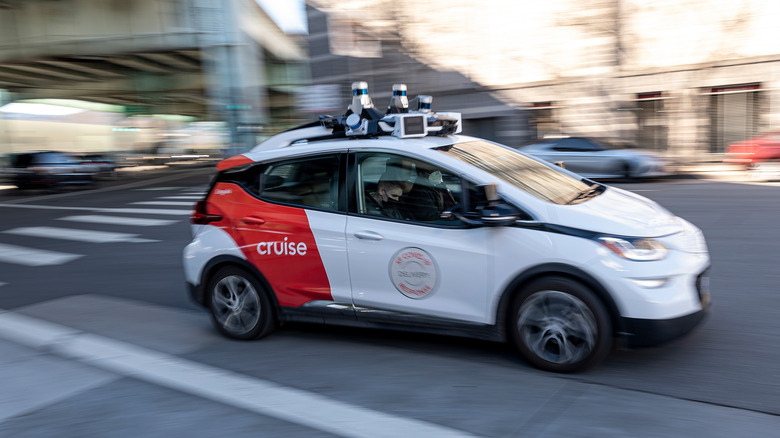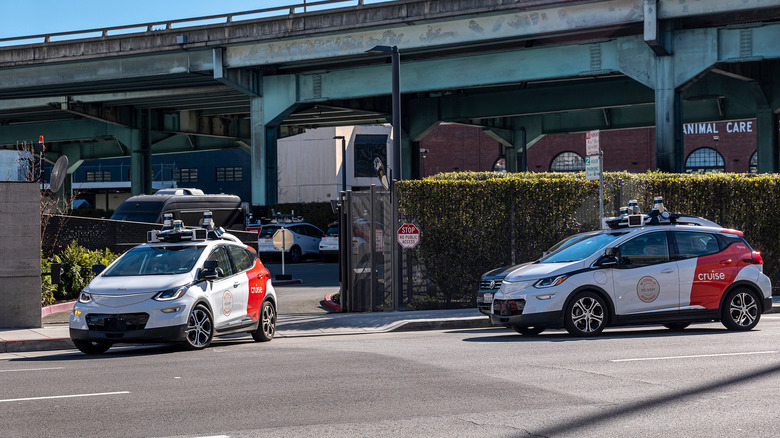Futuristic Driverless Taxis Are Already Causing Major Issues
Autonomous vehicles may have been hailed as a way to avoid urban congestion, but clearly, a few of Cruise AV's robotic taxis didn't get that memo in San Francisco this week. The GM-backed driverless car company has been operating a commercial robotaxi service in the city since securing a permit back in early June 2022, but a Cruise traffic jam gnarled up one street for several hours only weeks later.
More than a half dozen of the converted Chevrolet Bolt EV hatchbacks ended up huddled together at the intersection of Gough and Fulton Streets in the California city. Photos of the driverless congestion promptly cropped up on the San Francisco sub-Reddit and on Twitter.
Some @Cruise robotaxis appeared to be stuck in SF last night at the corner of Gough St. and Fulton St.
Human ops apparently had to rescue them. Still some kinks to iron out. pic.twitter.com/eXDocjVfHU
— Taylor Ogan (@TaylorOgan) June 30, 2022
"We had an issue earlier this week that caused some of our vehicles to cluster together," a Cruise spokesperson told TechCrunch of the incident. "While it was resolved and no passengers were impacted, we apologize to anyone who was inconvenienced."
According to Cruise, while it was able to guide the cars remotely, actually clearing the street did require some human intervention on-site. That process could end up getting trickier still, should more robotaxi rescue be called upon, as Cruise plans to ditch the steering wheel and other physical controls in its autonomous cars.
Cruise wants a million AVs on the road by 2030
In fact, that's a key selling point of the Cruise Origin, the custom robotaxi design that it revealed at the start of 2020. Built for Cruise by key investor General Motors atop the same Ultium electric platform that the GMC Hummer EV and Cadillac Lyriq use, the pod-like AV has dual sets of sliding doors — one on each side — and can drive forward or backward depending on which direction is most convenient. Passengers will be able to summon the vehicle with a smartphone app, and when inside can control and monitor their journey through integrated touchscreens.
The goal, Cruise has said, is to have a million autonomous vehicles on the road by 2030. That's ambitious, but being the first company in California to secure a Driverless Deployment Permit was an important first stage. While Cruise had been offering rides beforehand, often with a safety driver on board just in case the computers needed some assistance, it's now beginning to offer paid rides too.
This isn't Cruise's first run-in with the law
It's unclear what the repercussions for Cruise might be, though a potential $76-per-car fine for blocking a street sweeper trying to do its cleaning seems like only the start. Regulations for autonomous vehicles have focused, understandably, on safety: both for those onboard, and everyone else around the car. However, there are some issues that even advanced sensors apparently can't entirely be prepared for.
Back in April 2022, for example, one of Cruise's vehicles was pulled over by the San Francisco Police Department after being spotted driving around with its lights off. A visibly-confused police officer approached the car, only to discover that there was no driver at the wheel.
Things escalated when the autonomous Bolt EV then drove forward, apparently trying to evade the officer. Cruise later explained that the location it had initially stopped at was deemed unsafe by the self-driving systems, so it moved to "the nearest safe location, as intended."
Safe roads require chattier robotaxis
Figuring out what, exactly, is "intended" and communicating that to other road users may end up being one of the biggest challenges as driverless cars attempt to merge with human-operated vehicles. Origin, the custom-designed AV, has sizable displays on its outer corners, which can be used to not only show numbers to identify the robotaxi to its latest customer but to communicate with other road users too. Other AV projects, however, have gone even further.
Mercedes' F 015 concept, for example, was emblazoned with animated light displays front and rear. The 2015 autonomous teaser could even project a virtual sidewalk or other graphics onto the road, giving pedestrians the go-ahead that it was safe to cross and that the driverless vehicle had spotted their presence. Two years later, Toyota gave its cutesy self-driving pod animated eyes, to reassure those around it that the computers weren't about to go "Mad Max" on them.
In the background, of course, technologies like vehicle-to-vehicle (V2V) and vehicle-to-infrastructure (V2I) will do the heavy lifting. That'll allow cars to intercommunicate with each other and the city around them, effectively giving them an awareness of the driving environment beyond the range of their own sensors.
The cause of the robo-gridlock is still a mystery
That's all very promising, but it's clear that something got Cruise's current fleet snarled up, and — so far, at least — the multi-billion-dollar company isn't saying what it was. One possible culprit is that, like with other autonomous vehicle projects, Cruise relies on a crowdsourced map that evolves dynamically as each car feeds back the discoveries of its 40+ sensors.
Right now that means more than two million collective miles of data, Cruise boasts, with even new additions to the fleet benefiting from their predecessors' learnings. However, just like Google Maps or Apple Maps can sometimes end up directing you — and everyone else — right into a traffic jam, it's possible that Cruise's algorithms ended up navigating this cluster of cars into the same street, whereupon some glitch left them stranded. Bad news for Cruise, but at least stationary AVs can't be accused of knocking pedestrians down.


